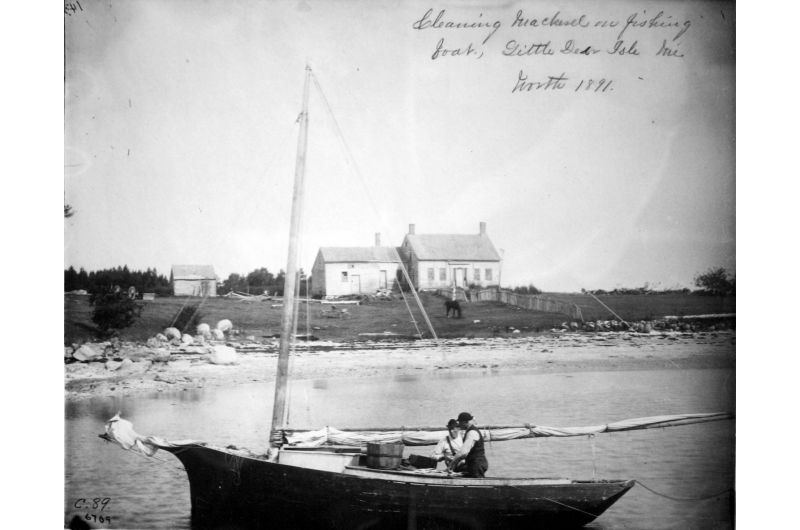New England's 1816 'Mackerel Year' and climate change today

Hundreds of articles have been written about the largest volcanic eruption in recorded history, at Indonesia's Mt. Tambora just over 200 years ago. But for a small group of New England-based researchers, one more Tambora story needed to be told, one related to its catastrophic effects in the Gulf of Maine that may carry lessons for intertwined human-natural systems facing climate change around the world today.
In the latest issue of Science Advances, first author and research fellow Karen Alexander at the University of Massachusetts Amherst and 11 others including aquatic ecologists, climate scientists and environmental historians recount their many-layered, multidisciplinary investigation into the effects of Tambora on coastal fish and commercial fisheries.
Alexander says, "We approached our study as a forensic examination. We knew that Tambora's extreme cold had afflicted New England, Europe, China and other places for as long as 17 months. But no one we knew of had investigated coastal ecosystems and fisheries. So, we looked for evidence close to home."
In work that integrates the social and natural sciences, they used historical fish export data, weather readings, dam construction and town growth chronologies and other sources to discover Tambora's effects on the Gulf of Maine's complex human and natural system.
The 1815 eruption caused a long-lasting, extreme climate event in 1816 known as the "year without a summer." As volcanic winter settled on much of the Northern Hemisphere, crops failed, livestock died and famine swept over many lands. In New England, crop yields may have fallen by 90 percent. The researchers found that 1816 was also called "the mackerel year," a clue to what they would find regarding fisheries.
Besides Tambora's climate effects, the authors examined other system-wide influences to explain observed trends. These included historical events such as the War of 1812, human population growth, fish habitat obstruction due to dam building and changes in fishing gear that might have affected fisheries at the time. Employing historical methods in a Complex Adaptive Systems approach allowed them to group and order data at different scales of organization and to identify statistically significant processes that corresponded to known outcomes, Alexander says.
For instance, temperature fluctuations influenced the entire Gulf of Maine for short periods of time, while dam construction affected individual watersheds through the life of the dams. Space and time scales differ in each case, but both temperature fluctuations and habitat obstructions affect fish, and thus fisheries, at the same time. Such interactions are characteristic of complex systems, she notes.
Establishing timing was key to solving the mystery, Alexander adds. Major export species including freshwater-spawning alewives and shad and marine-spawning mackerel and herring, have different temperature tolerances and seasonal migration patterns and timing, or phenology. Alewives and mackerel arrived earlier when water was colder, shad and herring arrive later after water had warmed up. Because of their phenology and vulnerability in rivers and streams during spawning, alewives suffered the most from the extreme climate event. In Massachusetts where streams had been dammed for a long time, its effects were compounded, the researchers found.
In the early 1800s alewives were a "utility fish," an important commercial export but also used as chicken feed, garden fertilizer and human food in winter. The winter of 1816 was so cold, Alexander says, that "Penobscot Bay froze solid from Belfast to Castine." When alewives arrived at their seasonal spawning time, adverse conditions likely disrupted spawning runs, increased natural mortality and, critically for the people depending on them, decreased catch.
She adds, "During this climate crisis, people couldn't catch enough alewives to meet their needs, so they quickly turned to mackerel, the next abundant species to arrive along the coast. Pursuing mackerel and rapidly distributing it to communities with no other sources of food fundamentally altered the infrastructure of coastal fisheries." Although records suggest that alewife populations apparently recovered within 25 years, "people responded rapidly and effectively to Tambora in only five years and never looked back when the crisis passed."
Rates of human and alewife response became uncoupled and the quick fixes, become permanent, later achieved an air of inevitability, the authors suggest.
They add that "complex solutions elude simple explanations." They point out the "many and obvious," parallels between that sudden extreme event and current occurrences of drought, flood, storm devastation, food disruption and famine attributed to climate change.
"The past can be a laboratory," Alexander and colleagues write. Employing historical methods within a Complex Adaptive Systems approach may offer a simple way to examine complex systems where scale, rate and phenology interconnect human and natural processes, and help to "advance human resilience by strengthening resilience in the natural world."
UMass Amherst fisheries ecologist Adrian Jordaan adds, "When the resources are available locally, they can help societies cope with change. Also, during extreme climate events, unthinkable changes including large societal shifts can occur. These are things that we must be prepared for in the world of today, where extreme climatic events are becoming more frequent and severe."
Michelle Staudinger, an ecologist with the Northeast Climate Science Center at UMass Amherst, says, "Alewives and other fishes that inhabit both rivers and oceans are highly vulnerable to climate change. The lessons learned from this study will help us better anticipate, prepare and cope for additional future impacts on their populations as well as the human communities that depend on them."
Alex Bryan, a U.S. Geological Survey climate scientist and co-author, says studying a 200-year-old event was a challenge. "Long-term temperature records don't begin until the turn of the 20th century. Fortunately, we found the weather journal of a physician residing in Salem, Mass., who recorded the air temperature four times a day from the 1780s to the 1820s. Without his devotion to monitoring the weather, this study would not have been possible."
More information: "Tambora and the mackerel year: Phenology and fisheries during an extreme climate event," Science Advances, advances.sciencemag.org/content/3/1/e1601635
Journal information: Science Advances
Provided by University of Massachusetts Amherst


















